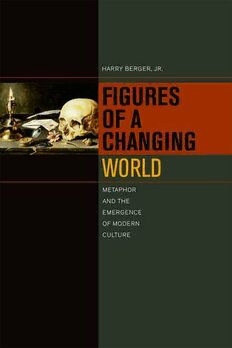
Figures of a Changing World: Metaphor and the Emergence of Modern Culture PDF
Preview Figures of a Changing World: Metaphor and the Emergence of Modern Culture
Figures of a Changing World This page intentionally left blank harry berger, jr. Figures of a Changing World metaphor and the emergence of modern culture Fordham University Press New York 2015 Copyright © 2015 Fordham University Press All rights reserved. No part of this publication may be reproduced, stored in a retrieval system, or transmitted in any form or by any means—electronic, mechanical, photocopy, recording, or any other—except for brief quotations in printed reviews, without the prior permission of the publisher. Fordham University Press has no responsibility for the persistence or accuracy of URLs for external or third-party Internet websites referred to in this publication and does not guarantee that any content on such websites is, or will remain, accurate or appropriate. Fordham University Press also publishes its books in a variety of electronic formats. Some content that appears in print may not be available in electronic books. Visit us online at www.fordhampress.com. Library of Congress Cataloging-in-Publication Data available online at catalog.loc.gov. Printed in the United States of America 17 16 15 5 4 3 2 1 First edition for Helen This page intentionally left blank contents Acknowledgments ix Part I: Theory and Practice 1. Two Figures: (1) Metaphor 1 2. Two Figures: (2) Metonymy 10 3. Making Metaphors, Seeing Metonymies 14 4. Metonymy, Metaphor, and Perception: De Man and Nietzsche 25 5. Metaphor, Metonymy, and Redundancy 42 6. The Semiotics of Metaphor and Metonymy: Umberto Eco 54 7. Frost and Roses: The Disenchantment of a Reluctant Modernist 68 Part II: History 8. Metaphor and the Anxiety of Fictiveness: St. Augustine 75 9. Metaphor and Metonymy in the Middle Ages: Aquinas and Dante 82 10. Sacramental Anxiety in the Late Middle Ages: Hugh of St. Victor, the Abbot Suger, and Dante 94 11. Ulysses as Modernist: From Metonymy to Metaphor in Shakespeare’s Troilus and Cressida 115 Notes 125 Index 153 vii This page intentionally left blank acknowledgments Figures of a Changing World began its existence a long time ago. I moved from New Haven to Santa Cruz in 1965, and in the next year I was joined by my former Yale colleague H. Marshall Leicester, now an eminent Chaucerian and fi lm scholar. During that year Marsh and I used to get together almost daily to work on an essay on Beowulf. I remember our sitting in a room that wasn’t yet furnished: no chairs or tables or couches or books. What we sat on and worked on was the carpet: a vita nuova in an empty room. It was then that we began wor- rying about the diff erences among tropes, or fi gures of speech. The basic distinctions between metaphor and metonymy that structure the present book thus took root in discussions that occurred almost a half-century ago. Though both of us have relocated several times, today we’re neighbors again. Since I’ve been indebted to Marsh for so many things—things that transcend tropes—during the intervening years, it gives me the greatest pleasure to thank him for the light he shone then and continues to shine now on the thinking and writing and living we’ve done and still do together. I decided a few years ago to try to fi nish the study of tropes that was initiated in my meetings with Marsh. This would have been a lot harder to do if I hadn’t been blessed with other sources of assistance and support. Once again, as so often before, my wife, Beth Pittenger, suggested a number of changes that sharpened the interpretive points ix
